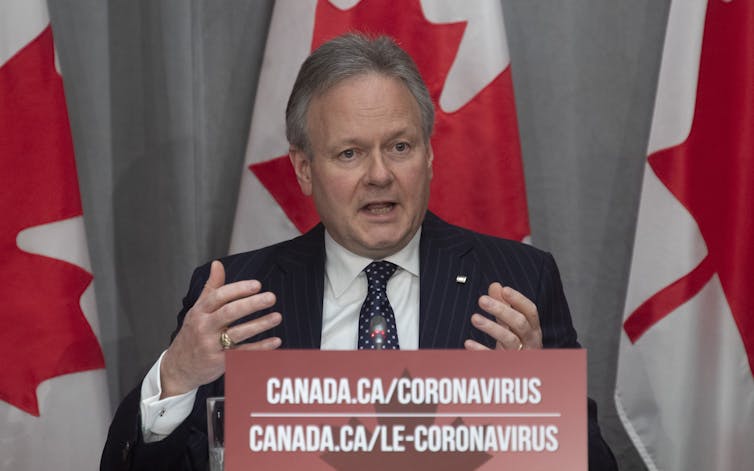

Marc-Andre Pigeon, University of Saskatchewan
Canada’s provinces are in trouble.
Even before the coronavirus pandemic crisis, resource-dependent provinces like Newfoundland and Labrador and Alberta were in trouble. Now they are bumping up against an unprecedented public health crisis and their provincial peers, many of whom have similarly worrying debt-to-GDP ratios, are probably not far behind.
Newfoundland and Labrador Premier Dwight Ball recently released a letter he sent to Prime Minister Justin Trudeau which said his province was facing an “immediate and urgent financial crisis” and that the provincial government had been unable to raise short- and long-term borrowing. He wrote:
“We have no other recourse to raise the necessary funds to maintain the operations of government, including our health care system, especially at this critical time.”
Four days after the letter was sent, the Bank of Canada promised to buy up to 40 per cent of all new provincial debt. Since then, the bank has purchased more than $1.3 billion of provincial debt, although it is unclear from which provinces.
Newfoundland has since been able to raise $200 million to help pay its bills, albeit at a hefty premium to what it would normally expect to pay for a short-term loan.
Central bank must do more
But more may be needed as the COVID-19 crisis lingers. Provincial revenues are collapsing even as expenses soar, all conspiring to push provincial debt-to-GDP ratios sharply higher. The Bank of Canada, whose sole shareholder is the federal government, should consider doing more — including making short-term zero-interest loans to the provinces to relieve lingering fiscal pressure for the duration of the crisis.
If the government can make available zero per cent loans to small businesses, surely it can contemplate the same for provinces and their municipalities that have to shoulder big coronavirus-related spending.
But can the Bank of Canada make these loans? The Bank of Canada Act says it can. Section 18 provides the Bank of Canada the power to make short-term loans to the provinces. It also has the power to buy federal and provincial debt.

So where will the money come from? Like most central banks, the Bank of Canada has the power to create new money by keystroking entries that effectively credit the accounts of whoever is selling it assets. In fact, while COVID-19-related asset purchases are unprecedented, the bank routinely uses this same power to purchase a share of all new federal debt.
The Bank of Canada has previously tried to avoid using “quantitative easing” to stimulate the economy, unlike other central banks that put trillions of dollars into the world’s economy during the 2008 financial crisis. But now Bank of Canada Governor Stephen Poloz feels he has no choice but to start buying assets on an unprecedented scale.
Inflationary concerns?
But won’t Bank of Canada support for the provinces lead to inflation? Maybe. Supply has been crimped. But a bout of inflation is highly unlikely given the precipitous drop in energy costs, disappearing effective demand and related idle capacity in the form of unemployment and silent factories. And if it does lead to inflation, we can manage that problem later. Right now, the provinces need help because many of us need help to put food on the table, pay rents and pay our debts.
Some policymakers will undoubtedly object that this would create a moral hazard, a term economists use to explain when the risk from someone’s decision is offloaded onto others. Isn’t the crisis in Newfoundland and Labrador just the result of decades of mismanagement? Why doesn’t Alberta tax more? And how can we know the provinces will spend the money wisely?
There are two responses to these kinds of arguments. First, this is the worst possible time to introduce a sales tax in Alberta or for other provinces to increase their sales tax rates. Second, there is no guarantee that bad investments won’t be made, but the level of scrutiny by the media and opposition parties is such that politicians know bad decisions will incur swift social sanction. The electorate is awake. Politicians beware.
There are other options too. The Bank of Canada could continue to buy provincial debt, but increase its share to something closer to 100 per cent. The federal government could promise to flow the resulting interest payments back to the provinces. Or the bank could issue a temporary blanket guarantee for all provincial debt and drive yields down to federal levels.
A COVID-19 grant
There is another more simple option. The Bank of Canada could buy new short-term federal debt — at zero interest or prevailing rates, it doesn’t matter because the Bank is owned by the government — and let the federal government transfer funds to the provinces at no net cost. Consider it a COVID-19 grant.
The Bank of Canada was established during the Great Depression to deal precisely with the kind of systemic event we now confront. But even facing a depression, policymakers let moral hazard worries keep them on the sidelines, causing one province (Alberta) to default on its debt. This cannot happen again. Nor should provinces refrain from making needed emergency interventions because of a nagging worry about their ability to fund spending.
The human cost is too great, the stress on our federation too irreversible. The federal government needs to live up to Trudeau’s promise to “do what it takes” to get Canada through this crisis. The provinces need the federal government to put the Bank of Canada to work. We all do.
Marc-Andre Pigeon, Assistant Professor, Johnson Shoyama Graduate School of Public Policy, University of Saskatchewan
This article is republished from The Conversation under a Creative Commons license. Read the original article.